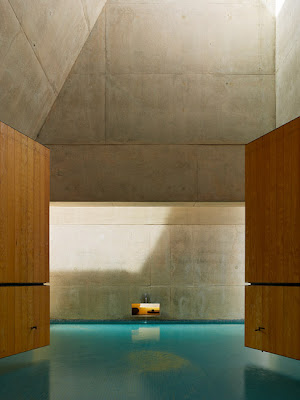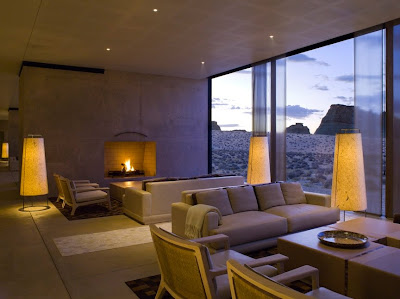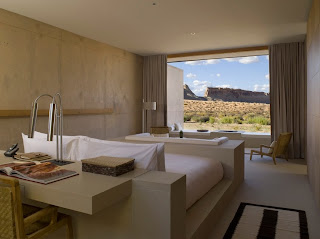The Solace of Distant Landscapes
The resort has an enveloping sense of privacy and calm. Some guests use the location as a base for exploring the region, heading to Lake Powell or nearby national parks, or they go on horseback to explore canons, or take guided excursions to nearby slot canyons.
Where is this Paleolithic landscape? It’s on the lower edge of southeastern Utah, near the New Mexico and Arizona borders, and not far from southern Colorado.
Haute Hiking
The terrace of my suite opens directly onto Henry Moore-like sandstone rock formations that surround the resort like a stage set, operatic and awe-inspiring.In the green foreground, chapparal is vivid with native flowers and sagebrush.
After an hour’s trekking in the bright sun, which included rock-climbing up through a slot canyon and up and down one side of a butte, he said, ‘We could go back, or we could continue up to the top of this butte. There’s a great view.” We continued. It felt unmapped, with no signs of previous hikers.
“You are here on the most beautiful day of the year,” my genial guide Mike said. “The wildflowers are at their peak.”
The hotel, which centers on a grand entry/ reception/ sitting rooms, a central study/game room/ and dining pavilion with an open kitchen, also includes an impressive gym, a yoga studio with windows that open to the view, sun terraces, pools, and outdoor relaxation areas.
Principal photographs of the architecture and landscape are by San Francisco Joe Fletcher, used here with permission.
Joe Fletcher is a SF based photographer, who specializes in architecture, interiors and significant places
His work has been published in.Wallpaper, AD, AR, San Francisco magazine, Interior Design and Sunset. Plus two books by Rizzoli, ‘Ranch Houses - Living the California Dream’ and ‘Cliff May and the Modern Ranch House’.
He is currently working on photography for a Jonathan Feldman + Jay Jeffers project. He is involved with numerous other projects, including a book on desert houses and a book on India.
Fletcher spent 3 days at Amangiri photographing the resort “It was probably the most beautiful architecture for a resort I’ve ever seen. I loved the subtle changes in the concrete color over the building achieved by adding localized stone” said Fletcher.
His next assignment: to shoot a Libeskind apartment in Denver for Wallpaper*.
Joe Fletcher Photography
I’ve just returned from an exciting and rare journey—far away, to the dramatic, raw beauty of southern Utah, close to the Arizona and New Mexico borders.
AmanResorts, the super-luxe company that invented the concept of small, sublime luxury resorts in Asia, recently opened Amangiri, their second ultra-luxury resort in the United States. (The first, Amangani, is in Jackson Hole.)
Amangiri is a glorious, sublime adventure, totally original and inspiring.
I arrived in the early afternoon when the sun was at its most intense. Canyons, buttes, caves, rockfalls, and wind-formed rock arches are highlighted in brilliant chiaroscura. I can’t wait to go and explore this dramatic place.
Set on 600 private acres, Amangiri is at the edge of its own mini Grand Canyon, with open views of blue-shadowed mesas and buttes and endless mystic mountains.
Set on 600 private acres, Amangiri is at the edge of its own mini Grand Canyon, with open views of blue-shadowed mesas and buttes and endless mystic mountains.
The property is truly private, with Bureau of Land Management expanses on one corner, and Navaho Nation lands all around. The nearest town, Page, Arizona, is half-an-hour’s drive away.
I love the Aman luxury here, the remoteness, the looming sphinx-like rock outcrops, the silence, the still desert air, and the sense of quiet discovery every moment.
The resort has an enveloping sense of privacy and calm. Some guests use the location as a base for exploring the region, heading to Lake Powell or nearby national parks, or they go on horseback to explore canons, or take guided excursions to nearby slot canyons.
This privacy (some suites have hidden and secluded entry doors) has attracted Hollywood’s A-list actors and producers, as well as the art world and anyone who seeks momentary anonymity.
I’ve heard from friends who recently stayed at Amangiri that it has become popular with Hollywood types like Meg Ryan and Rob Reiner, and design/style/publishing talents like Prosper and Martine Assouline. Guests fly in from L.A. or New York on private jets. It’s not unusual for guests to arrive from Paris or London, or New York. (Aman never discusses guests.)
There are two lavish suites designed so that guests who desire total privacy are never seen, with large terraces, pools, a terrace spa, a roof deck for sunbathing or moon-gazing, and a large dining room. Privacy—the ultimate luxury.
The Perceptual Field
The Perceptual Field
Architects Wendell Burnette and Marwan Al-Sayed from Phoenix, and Rick Joy from Tucson designed the resort. They collaborated with Adrian Zecha, the legendary guiding force of Aman, to keep the architecture understated but luxurious, and to integrate it seamlessly within the surrounding landscape.
The concept was to build a kind of desert fort to provide a sense of peace and a feeling of front-row seats to observe winter snowfalls, spring wild-flowers, sunset light, delicate sunrise. Every window and wall of the resort frames a view.
But the property sits lightly on the land, almost disappearing at twilight, and seeming rather modest and elegantly discreet.
Exterior and interior walls are made of integrated-color board-formed concrete mixed with sandstone, pebbles and stones, and clay from the region. The natural variegations, imperfections and color modulations add to the walls’ pale beauty. They look like weatherworn stone.
My suite is modernist and spare, and chic, setting a new contemporary standard for southwest interiors. Not a kachina doll in sight.
The walls of the suites are also integral-color panel-formed concrete. They look like sandstone, and feel smooth and silken to the touch. The bed is set high so that, wrapped in Italian cotton sheets, you can see sunrise across the high desert.
The silence is penetrating. As I walk from my suite to the main pavilion, I pass waterfalls, pools, shaded cave-like lobbies, and narrow hallways inspired by slot canyons of the region.
“Amangiri is like a luxurious monastery—with the feeling of a place for retreat and contemplation. I admire the architecture enormously. It is built with great precision and intelligence. The architecture is all about exactitude and perfection.” —San Francisco architect Andrew Skurman, who recently stayed at Amangiri. Check THE STYLE SALONISTE archive for my recent feature on Andrew Skurman’s architecture.
Where is this Paleolithic landscape? It’s on the lower edge of southeastern Utah, near the New Mexico and Arizona borders, and not far from southern Colorado.
It’s near Lake Powell, and Bryce Canyon, two hours’ drive north of the Grand Canyon, and not far from Zion National Park.
French and German tourists mill about at tiny Page airport, excited to see the John Ford-esque monuments of rock and stone, the legendary western high desert and canyons. I feel their anticipation.
How to get there? I fly to Denver and take a Great Lakes Airlines Beechcraft (13-seater, prop planes) to Page, via Farmington. Then a half-hour drive to Canyon Point, and Amangiri.
We pass through acres of wildflowers and sagebrush and flowering yucca and lupines. Buttes tower in the endless sand dunes, and circle the sparse rocky acres, green now in early summer.
We pass through acres of wildflowers and sagebrush and flowering yucca and lupines. Buttes tower in the endless sand dunes, and circle the sparse rocky acres, green now in early summer.
Haute Hiking
The terrace of my suite opens directly onto Henry Moore-like sandstone rock formations that surround the resort like a stage set, operatic and awe-inspiring.In the green foreground, chapparal is vivid with native flowers and sagebrush.
This is how it would have looked millennia ago, with no roads and structures in sight.
I start the day with breakfast on my terrace, watching the winds ruffle across the sagebrush.
At 10am, I meet Mike, the expert guide from Adventure Partners who designed private trails on the property. We set out for the Hoodoo trail (a hoodoo is a rock formation), and as we marched up and over sand dunes crowded with blue lupines, he continues a fascinating running commentary on geology, rocks, plants, and millennia of floods and winds and plate tectonics. Great stuff.
After an hour’s trekking in the bright sun, which included rock-climbing up through a slot canyon and up and down one side of a butte, he said, ‘We could go back, or we could continue up to the top of this butte. There’s a great view.” We continued. It felt unmapped, with no signs of previous hikers.
“You are here on the most beautiful day of the year,” my genial guide Mike said. “The wildflowers are at their peak.”
The hike stretched to more than 3 hours—with stops at caves with petroglyphs, and rock formations teetering on the edge.. We scope out fresh imprints on the sand left by lizards, snakes, coyote, bugs, skittering rabbits, and other native creatures.
In the distance you can hear the desert winds riff off the rock canyons and meandering dunes. A dust devil whirls through the sagebrush, pirouetting itself into a cloud and disappearing off-stage.
I could have kept walking, but we eventually headed back.
Lunch of fresh tortilla soup and oven-roasted salmon never tasted so wonderful.
Chefs are preparing fresh ingredients all day in the open kitchen, making varieties of bread (the rosemary bread is especially wonderful), and glorious salads and sandwiches for lunch. The style of cuisine is somewhat southwestern, and the wood-fired oven adds a sensual smoke flavor, but the chefs can create any dish for hungry guests.
In the afternoon, I set out with Karen, a guide with a special interest in local botany, and as we clambered up rocks and slithered down sand dunes, she identifies desert tobacco, rose mallow, pink sand verbena, white prickly poppy, and desert milkweed, and blazing star, as well as all the yucca varieties.
She pointed out pale fluorescent mauve sacred datura, with strange trumpet-shaped petals. Pollinated by hawk moths at night, it’s poisonous, she said. Indian shamans ingested the seeds to go into a trance and contact guardian spirits. Hello, Timothy Leary!
“You are here on the most beautiful day of the year,” she echoed Mike. “The wildflowers are outstanding.” (Note to self: book a visit next spring.)
We arrived at a cave where early pottery shards and bones have been found. Scratched on the rocks are petroglyphs of watercarriers, stick figures, and a large-headed creature.
We continued on, past sand washes where floods had swept in mid-winter, and across sandstone ledges and shelves to gain new views. I loved the rock-climbing, and learned new techniques.
After the long hike, I enjoyed dinner on the terrace of my suite. In the black sky, the stars were gazing down brightly. Constellations and favorite stars are clearly visible, with a rare sense of deep space, and our tiny planet like a speck of sand in the infinite void.
Amangiri’s thirty-four suites and spa are fanned out around a majestic rock formation, so that the resort seems quite small. Up close, it looks like a large residence, with a grove of aspens shimmering in the arrival courtyard, broad stairs rising to the entrance, and framed views of the mesas and wind-formed buttes beyond.
‘The Utah deserts and plateaus and canyons are a country for contemplation, meditation, solitude, quiet awe, and peace of mind.’—Wallace Stegner
‘In this glare of brilliant emptiness
In this arid intensity of pure heat
In the heart of a weird solitude
Great silence.
And all things recede to distances out of reach.’
—Edward Abbey
Amangiri’s thirty-four suites and spa are fanned out around a majestic rock formation, so that the resort seems quite small. Up close, it looks like a large residence, with a grove of aspens shimmering in the arrival courtyard, broad stairs rising to the entrance, and framed views of the mesas and wind-formed buttes beyond.
Here, the blue veils of light fade and intensify as the sun sweeps overhead. Columns of sandstone seem to shimmer in the bright light.
The spa, set in a dramatic Barragan-inspired modern structure, includes a sauna, a steam room, an outdoor pool, and a series of super-quiet treatment rooms. My favorites were a series of shaded pavilions with a large cushy bed, perfect for a Thai massage overlooking a private canyon. Many guests spend much of their time at the spa. Who would ever want to leave when there are mysterious ‘journey’ treatments—along with a glamorous makeup room (with a specialist), and a salon for manicures and pedicures.
“This is an ideal retreat from the noise and cares of the world. Between the rocks, the wind-shaped stones, and the sand dunes, I felt I was not on this earth. I was elsewhere.” —San Francisco sculptor Francoise Skurman. She recently stayed at Amangiri
‘I have been to the end of the earth
I have been to the end of the waters
I have been to the end of the sky
I have been to the end of the mountains
I have found none that are not my friends’
—Traditional Navaho poem
Principal photographs of the architecture and landscape are by San Francisco Joe Fletcher, used here with permission.
Joe Fletcher is a SF based photographer, who specializes in architecture, interiors and significant places
His work has been published in.Wallpaper, AD, AR, San Francisco magazine, Interior Design and Sunset. Plus two books by Rizzoli, ‘Ranch Houses - Living the California Dream’ and ‘Cliff May and the Modern Ranch House’.
He is currently working on photography for a Jonathan Feldman + Jay Jeffers project. He is involved with numerous other projects, including a book on desert houses and a book on India.
Fletcher spent 3 days at Amangiri photographing the resort “It was probably the most beautiful architecture for a resort I’ve ever seen. I loved the subtle changes in the concrete color over the building achieved by adding localized stone” said Fletcher.
His next assignment: to shoot a Libeskind apartment in Denver for Wallpaper*.
Joe Fletcher Photography
415 216 7948
www.joefletcherphotography.com
Interior Design: Caterina Spies-Reese, CSR Design, Glen Ellen, California
www.joefletcherphotography.com
Additional hotel and scene photography, courtesy AmanResorts
Interior Design: Caterina Spies-Reese, CSR Design, Glen Ellen, California
For more information and reservations at Amangiri:
www.amanresorts.com






































































